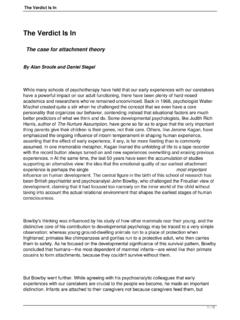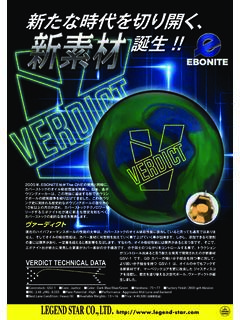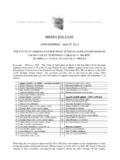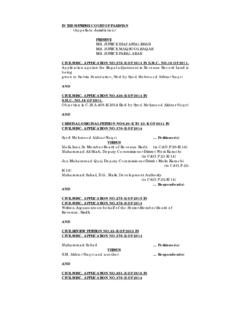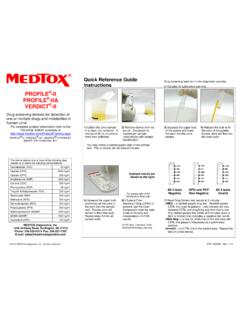Transcription of DIRECTED VERDICT: DEFENDING AGAINST IT AND …
1 1 DIRECTED VERDICT: DEFENDING AGAINST IT AND PURSUING IT By Elizabeth A. Leone I. INTRODUCTION As Plaintiff s attorneys who practice personal injury, we rarely give a second thought to DIRECTED verdict. After all, how hard is it to prove a typical auto accident case? You show negligence, you show causation, you show damages, and you ve met your burden. Not too difficult. In fact, rarely do we have to argue to the judge our positions; DIRECTED verdict motions by the defense attorney are usually summarily denied in our auto accident cases. Why are these over with so quickly?
2 And without the judge wanting to hear our pearls of wisdom? It is because the Defendant bears an extremely heavy burden in establishing grounds for a DIRECTED verdict. These motions are frowned upon by the courts and are rarely granted in negligence cases. We have become accustomed to this in the courtroom and we can take that for granted. There will come the day when you may inadvertently leave out an element, or it may be an extremely close issue on negligence, and you will be called upon to defend AGAINST this motion. It is best to be prepared and know the general case law should the need arise.
3 More importantly, as Plaintiff s attorneys, we can use DIRECTED verdict in our favor; that is, go on the offensive and make these motions in appropriate circumstances. We bear an equally heavy burden when making a motion for DIRECTED verdict, but these motions can be won. II. PURPOSE OF DIRECTED VERDICT Rule 50 of the North Carolina Rules of Civil Procedure provides the framework for motions for DIRECTED Verdict and for Judgment Notwithstanding the Verdict (JNOV). DIRECTED verdict was designed to save the time and trouble involved in a jury determination by enabling the court to determine whether a question of fact exists and whether the law requires a particular The purpose of DIRECTED verdict was to test the legal sufficiency of the evidence to take the case to the jury and to support a verdict for the plaintiff.
4 2 While this manuscript makes mention of the JNOV motion, it concentrates mainly on DIRECTED verdict. DIRECTED verdict is now typically a tool used by the Defendant to challenge the sufficiency of the Plaintiff s evidence to go to the jury. But that was not always the case. It used to be that the DIRECTED verdict was more popular with the Plaintiff s bar than with the Defendant s (use in attacking Defendant s affirmative defenses). DIRECTED verdict was hardly used by Defendants because of the Plaintiff s absolute right to take a voluntary nonsuit at any time prior to verdict.
5 If the Plaintiff s attorney felt that a judge was going to direct verdict AGAINST him, he could take a voluntary nonsuit and refile his Because the Plaintiff s had this right to a 2 voluntary nonsuit at any time prior to verdict, the Defendant s abandoned their DIRECTED verdict practice as it was seemingly futile. However, under Rule 41 of the North Carolina Rules of Civil Procedure, a Plaintiff can take one voluntary dismissal only at some time prior to resting his case. After the Plaintiff rests, he cannot take a voluntary dismissal without leave of Court. This has made the DIRECTED verdict more appealing to Defendants and is now the only device by which an adverse party can challenge the sufficiency of the evidence to go before a When DIRECTED verdict is granted, it is judgment on the Rule 50 is fairly benign when trying to figure out how to use the Rule and who may use it.
6 Case law is helpful and instructive. Since the State and Federal Rules on DIRECTED verdict are virtually the same, federal law is also instructive. It is important to know at the outset that the DIRECTED verdict is not solely a tool for the Defendant. Any party can move for DIRECTED verdict at the close of all the III. STANDARD FOR DIRECTED VERDICT As stated above, it is very difficult for a Defendant to get a verdict DIRECTED in his favor in a negligence action. The general standard is the same as in summary judgment: consider the evidence in the light most favorable to the non-movant.
7 The Courts have refined and added to this generalized standard. There are dozens of cases available to quote the standard the Court uses on motions for DIRECTED verdict; but it is summed up accurately in McFetters v. McFetters, 98 App. 187, 390 348 (1990). There the Court summarized the standard that should be applied when deciding DIRECTED verdict. In deciding the motion, the trial court must treat non-movant s evidence as true, considering the evidence in the light most favorable to the non-movant, and resolving all inconsistencies, contradictions and conflicts for non-movant, giving non-movant the benefit of all reasonable inferences drawn from the evidence.
8 Also of import, the McFetter Court pointed out that evidence which raises a mere possibility or conjecture will not defeat a motion for DIRECTED verdict. BUT, if there is more than a scintilla of evidence, the Court must deny the motion. The McFetter Court, as well as other Courts, have consistently held that DIRECTED verdict should rarely be granted in negligence One reason is because application of the prudent man test is generally to be applied by a jury. The jury determines the facts; the judge determines the law. Almost always there is a dispute to the facts, and if not, at least to the credibility of the witnesses.
9 These conflicts are to be resolved by the jury. DIRECTED verdict is never proper unless it appears as a matter of law that 3 recovery cannot be had by the Plaintiff upon any view of the facts which the evidence reasonably tends to When DEFENDING AGAINST a motion for DIRECTED verdict, point out to the court that the facts are to be viewed by applying the McFetter standard itemized above. IV. DEFENDING AGAINST DIRECTED VERDICT DOES THE PLAINTIFF HAVE A CASE? In an automobile accident case, the Plaintiff has to prove that he or she was injured as a result of the Defendant s negligence, and that they suffered damages there from.
10 Negligence is the failure to exercise the proper care in performance of a legal duty which the Defendant owes to the The Plaintiff will have verdict DIRECTED AGAINST him if he fails to establish the elements of actionable The Plaintiff must establish: 1. Defendant owed Plaintiff a duty of care 2. Defendant s actions or failure to act breached that duty 3. Defendant s breach was the actual and proximate cause of Plaintiff s injury 4. Plaintiff suffered damages as a result of such breach11 Negligence is a broad term encompassing the four elements above. However, it is often easier to think of proving your personal injury case by establishing 1) Negligence (duty/breach of duty), 2) Causation (Actual and Proximate) and 3) Damages.

